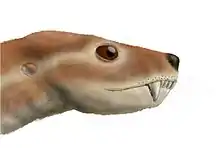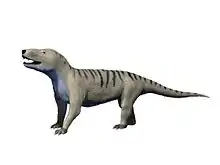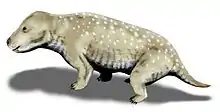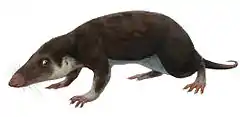Lumkuia
Lumkuia is an extinct genus of probainognathian cynodonts. It is the earliest and most basal known member of Probainognathia, with fossils being found from the Cynognathus Assemblage Zone of the Beaufort Group in the South African Karoo Basin that date back to the early Middle Triassic. Lumkuia is not as common as other cynodonts from the same locality such as Diademodon and Trirachodon.[1] Previously, early probainognathians were only known from younger strata in South America that were deposited in the late Middle and Late Triassic.[2][3][4][5][6][7][8] The genus has been placed in its own family, Lumkuiidae.
| Lumkuia Temporal range: Middle Triassic | |
|---|---|
 | |
| Scientific classification | |
| Kingdom: | Animalia |
| Phylum: | Chordata |
| Clade: | Therapsida |
| Clade: | Cynodontia |
| Clade: | Probainognathia |
| Family: | Lumkuiidae Hopson and Kitching, 2001 |
| Genus: | †Lumkuia Hopson and Kitching, 2001 |
| Species: | †L. fuzzi |
| Binomial name | |
| †Lumkuia fuzzi Hopson and Kitching, 2001 | |
The postcanines are similar to the later chiniquodontids, but the secondary palate is quite short in comparison, and the genus lacks the angulation of the ventral cranial margin seen in chiniquodontids.[9] Lumkuia can be seen as more derived than other contemporary cynodonts such as Cynognathus with the crowns of its teeth high and narrow and having inwardly curving tops. The genus was named in 2001 on the basis of the holotype specimen BP/1/2669, which can now be found at the Bernard Price Institute in Johannesburg, South Africa.
References
- Fernando Abdala, P. John Hancox and Johann Neveling (2005). Cynodonts from the Uppermost Burgersdorp Formation, South Africa, and Their Bearing on the Biostratigraphy and Correlation of the Triassic Cynognathus Assemblage Zone. Journal of Vertebrate Paleontology 25(1):192-199.
- Romer, A. S. (1969). The Chañares (Argentina) Triassic reptile fauna V. A new chiniquodontid cynodont, Probelesodon lewisi- cynodont ancestry. Breviora 333:1–24.
- Romer, A. S. (1970). The Chañares (Argentina) Triassic reptile fauna VI. A chiniquodontid cynodont with an incipient squamosaldentary jaw articulation. Breviora 344:1–18
- Martinez, R. N. and Forster, C. A. (1996). The skull of Probelesodon sanjuanensis, Sp. Nov., from the Late Triassic Ischigualasto Formation of Argentina. Journal of Vertebrate Paleontology 16:285–91.
- Martinez, R. N., May, C. L. and Forster, C. A. (1996). A new carnivorous cynodont from the Ischigualasto Formation (Late Triassic, Argentina), with comments on eucynodont phylogeny. Journal of Vertebrate Paleontology 16:271–84.
- Romer, A. S. (1969). The Brazilian Triassic cynodont reptiles Belesodon and Chiniquodon. Breviora 332:1–16
- Hopson, J. A. (1995). Patterns of evolution in the manus and pes of non-mammalian therapsids. Journal of Vertebrate Paleontology 15:615–39.
- Rubidge, B. S. and Sidor, C. A. (2001). Evolutionary patterns among Permo-Triassic theraspids. Annual Review of Ecology and Systematics 32:449-480.
- Hopson, J. A. and Kitching, J. W. (2001). A probainognathian cynodont from South Africa and the phylogeny of non-mammalian cynodonts. Bulletin of the Museum of Comparative Zoology 156(1):5-35








